December 7, 2015 at 3:37 pm
[caption id="attachment_1115" align="alignright" width="539"]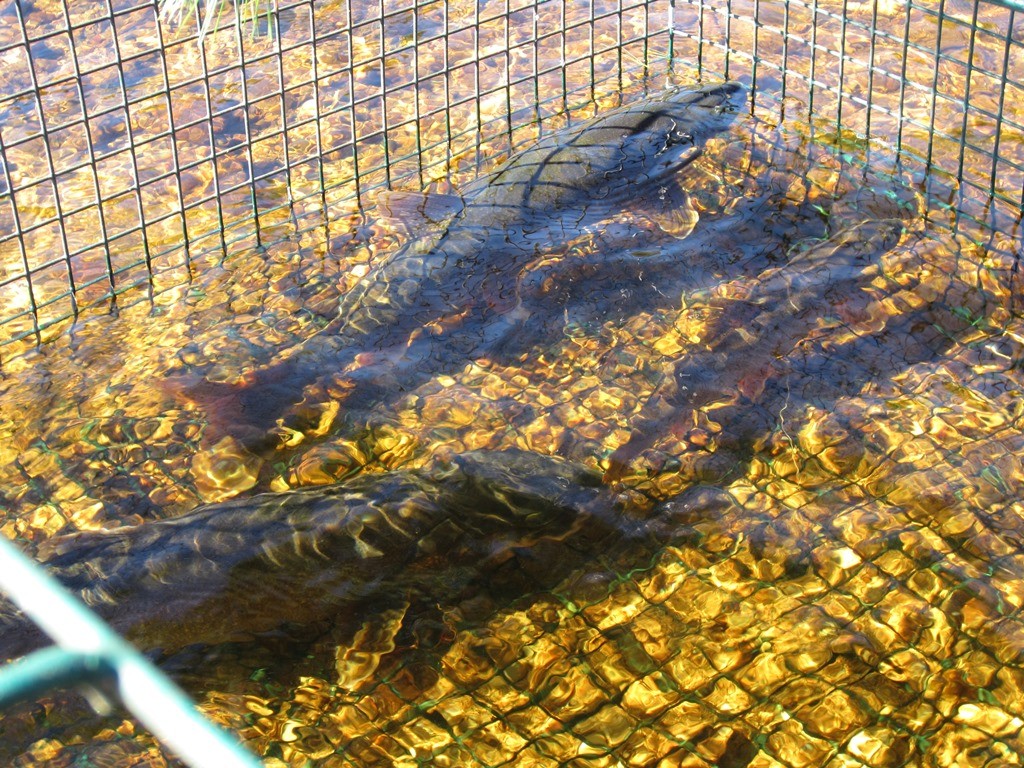 Lake trout, some in excess of ten pounds, were implanted with radio telemetry tags in order to track their movements.[/caption]
Modern technology benefits anglers and biologists alike. Tiny radio transmitters, surgically implanted into lake trout, are giving fishery scientists a glimpse into a togue’s travels.
“We want to know where the fish spawn so we can get a representative sample of the spawning population,” says IFW regional fisheries biologist Greg Burr.
Getting that representative sample of togue allows biologists to give the lake trout population a periodic “check-up” to make sure that the fishery is healthy and meeting Department goals for anglers.
Timing and location are the key to gathering the fish. Togue spawn at specific locations and in a narrow window of time. “Your net placement and timing have to be precise or you will miss the fish,” Burr said.
[caption id="attachment_1110" align="alignleft" width="436"]
Lake trout, some in excess of ten pounds, were implanted with radio telemetry tags in order to track their movements.[/caption]
Modern technology benefits anglers and biologists alike. Tiny radio transmitters, surgically implanted into lake trout, are giving fishery scientists a glimpse into a togue’s travels.
“We want to know where the fish spawn so we can get a representative sample of the spawning population,” says IFW regional fisheries biologist Greg Burr.
Getting that representative sample of togue allows biologists to give the lake trout population a periodic “check-up” to make sure that the fishery is healthy and meeting Department goals for anglers.
Timing and location are the key to gathering the fish. Togue spawn at specific locations and in a narrow window of time. “Your net placement and timing have to be precise or you will miss the fish,” Burr said.
[caption id="attachment_1110" align="alignleft" width="436"]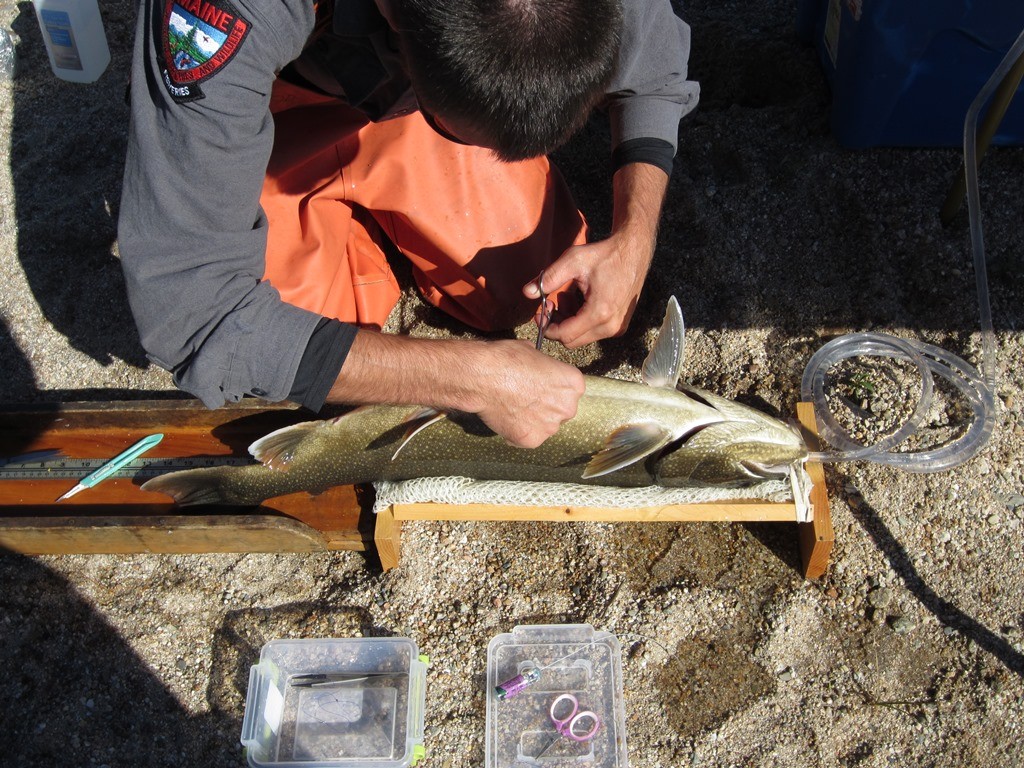 A biologist inserts a radio tag into a lake trout. An incisiion is made into the abdomen, the tag inserted and then the fish is stitched up. Clear plastic tubing delivers anesthetized water to the fish's gills, providing oxygen and keeping the fish still during the two to five minute procedure.[/caption]
Last year at Tunk Lake, biologists waited to sample togue until the water temperature got down to 50°F and were a little late and missed the spawn.
While biologists may be able to narrow down suspected spawning sites, there are no guarantees, so this year on Tunk Lake Burr and Biologist Joe Overlock captured lake trout early so they could follow their movements electronically.
Back in September they set out to catch and radio tag 10 mature lake trout in order to find out where they spawn. Using a finer mesh net than they normally would, they set the nets down deep on two separate nights in order to catch the fish they needed.
[caption id="attachment_1112" align="alignright" width="358"]
A biologist inserts a radio tag into a lake trout. An incisiion is made into the abdomen, the tag inserted and then the fish is stitched up. Clear plastic tubing delivers anesthetized water to the fish's gills, providing oxygen and keeping the fish still during the two to five minute procedure.[/caption]
Last year at Tunk Lake, biologists waited to sample togue until the water temperature got down to 50°F and were a little late and missed the spawn.
While biologists may be able to narrow down suspected spawning sites, there are no guarantees, so this year on Tunk Lake Burr and Biologist Joe Overlock captured lake trout early so they could follow their movements electronically.
Back in September they set out to catch and radio tag 10 mature lake trout in order to find out where they spawn. Using a finer mesh net than they normally would, they set the nets down deep on two separate nights in order to catch the fish they needed.
[caption id="attachment_1112" align="alignright" width="358"]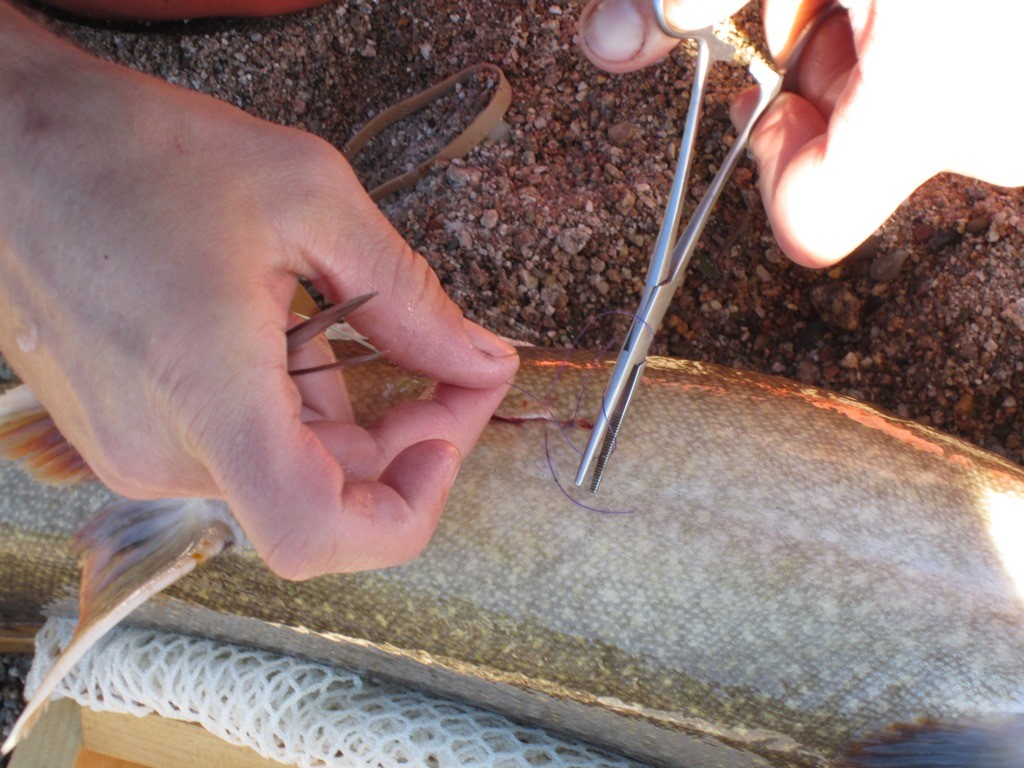 This lake trout is stitched up after the tag was inserted.[/caption]
The togue they captured were alive and well because they got tangled in the nets only by their teeth. If the togue was over 19”, it was anesthetized, a radio transmitter was implanted surgically, then it was released. All others were released alive immediately.
Once the togue were released, biologists then began to follow their movements. This year using the telemetry research they found that the fish spawned when water temperatures were between 52 and 57 degrees.
“We began tracking the fish at night starting on October 8th. Tunk is two thousand acres with a lot of very deep water and a maximum depth of 222 feet. Sometimes the fish were in such deep water that you just couldn’t find them, and then you would locate them in shallower water the next night you were tracking. Many of fish traveled great distances all over the lake before settling in on the spawning shoal,” said Burr.
Over the course of the fall, Burr and crew made eight night tracking trips to Tunk, and after following the togue, were able to pinpoint the spawning grounds.
“Basically we found two shoals. One was not a surprise, but we didn’t know about the other. Both were about 3-6 feet deep,” said Burr.
[caption id="attachment_1113" align="alignleft" width="354"]
This lake trout is stitched up after the tag was inserted.[/caption]
The togue they captured were alive and well because they got tangled in the nets only by their teeth. If the togue was over 19”, it was anesthetized, a radio transmitter was implanted surgically, then it was released. All others were released alive immediately.
Once the togue were released, biologists then began to follow their movements. This year using the telemetry research they found that the fish spawned when water temperatures were between 52 and 57 degrees.
“We began tracking the fish at night starting on October 8th. Tunk is two thousand acres with a lot of very deep water and a maximum depth of 222 feet. Sometimes the fish were in such deep water that you just couldn’t find them, and then you would locate them in shallower water the next night you were tracking. Many of fish traveled great distances all over the lake before settling in on the spawning shoal,” said Burr.
Over the course of the fall, Burr and crew made eight night tracking trips to Tunk, and after following the togue, were able to pinpoint the spawning grounds.
“Basically we found two shoals. One was not a surprise, but we didn’t know about the other. Both were about 3-6 feet deep,” said Burr.
[caption id="attachment_1113" align="alignleft" width="354"]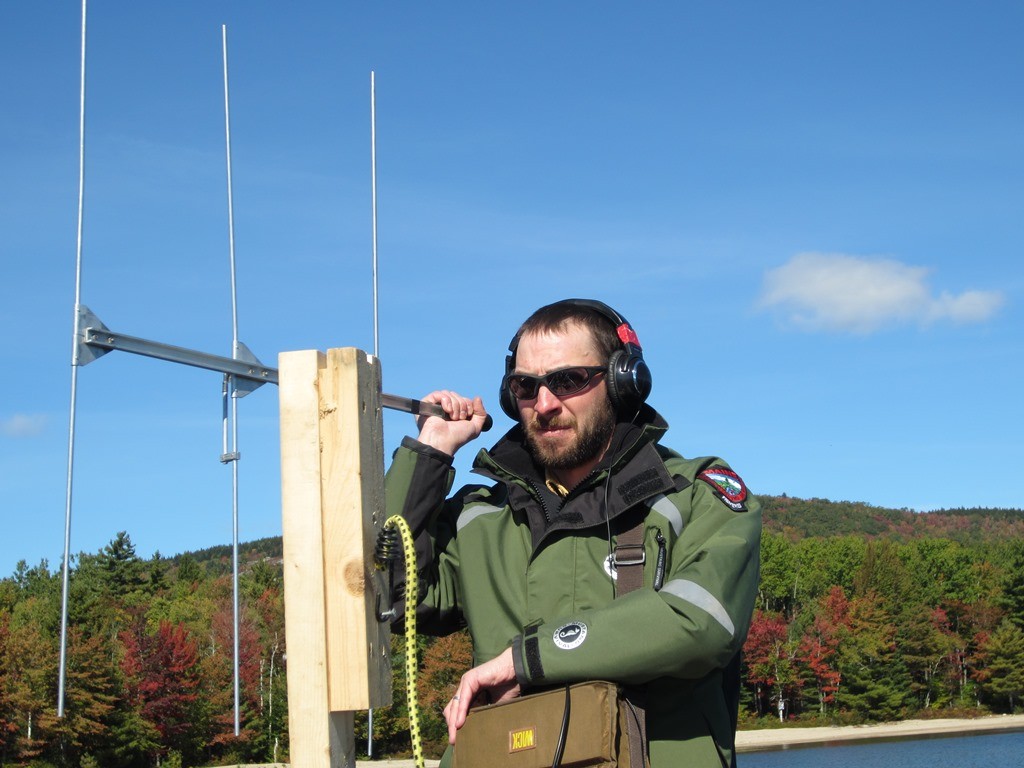 This antenna and receiver allows biologists to track the fish. Each fish has a distinct frequency.[/caption]
By tracking the fish, biologists can pinpoint where they congregate to spawn, allowing them to revisit the spawning shoal and attain a sample. They do this using a trap-net, which allows them to live capture a representative component of the population; weigh and measure them; and assess the health of the fishery.
That is important since the togue at Tunk are all wild from a population that was started in the 1930s. Currently the department no longer needs to stock togue as they reproduce naturally. However monitoring the population is essential so that their numbers do not become either over abundant or decline and upset the goals for the fishery. Since the department cannot adjust stocking numbers, tweaking the fishing regulations and sampling the population often are keys to keeping a topnotch fishery.
[caption id="attachment_1114" align="alignright" width="436"]
This antenna and receiver allows biologists to track the fish. Each fish has a distinct frequency.[/caption]
By tracking the fish, biologists can pinpoint where they congregate to spawn, allowing them to revisit the spawning shoal and attain a sample. They do this using a trap-net, which allows them to live capture a representative component of the population; weigh and measure them; and assess the health of the fishery.
That is important since the togue at Tunk are all wild from a population that was started in the 1930s. Currently the department no longer needs to stock togue as they reproduce naturally. However monitoring the population is essential so that their numbers do not become either over abundant or decline and upset the goals for the fishery. Since the department cannot adjust stocking numbers, tweaking the fishing regulations and sampling the population often are keys to keeping a topnotch fishery.
[caption id="attachment_1114" align="alignright" width="436"]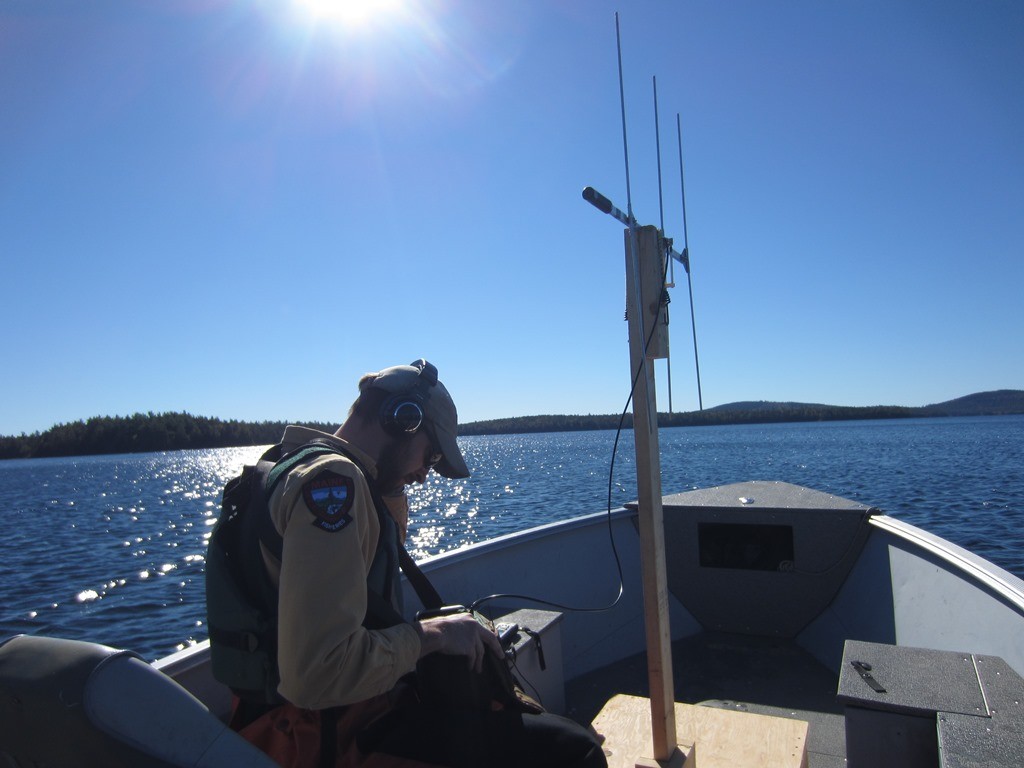 All location data is recorded and analyzed.[/caption]
“Our goals at Tunk are to increase the number of larger fish available to anglers. That is why we implemented the no-kill slot limit. Knowing where these fish spawn will allow us to follow the trend of larger spawning fish and show us if we are reaching our size goals. We want to provide the best fishery possible for those who decide to fish Tunk,” said Burr.
Currently, things are going well at Tunk. The length-to-weight ratios for togue and salmon are excellent, which is good news for fisherman looking to catch big fat fish.
“We are extremely pleased on how these fisheries are coming along at Tunk. Four of the ten togue tagged were over 10 pounds and we feel there many more like these or even larger out there. Anglers should be excited for the future,” said Burr.
[caption id="attachment_1116" align="alignleft" width="300"]
All location data is recorded and analyzed.[/caption]
“Our goals at Tunk are to increase the number of larger fish available to anglers. That is why we implemented the no-kill slot limit. Knowing where these fish spawn will allow us to follow the trend of larger spawning fish and show us if we are reaching our size goals. We want to provide the best fishery possible for those who decide to fish Tunk,” said Burr.
Currently, things are going well at Tunk. The length-to-weight ratios for togue and salmon are excellent, which is good news for fisherman looking to catch big fat fish.
“We are extremely pleased on how these fisheries are coming along at Tunk. Four of the ten togue tagged were over 10 pounds and we feel there many more like these or even larger out there. Anglers should be excited for the future,” said Burr.
[caption id="attachment_1116" align="alignleft" width="300"]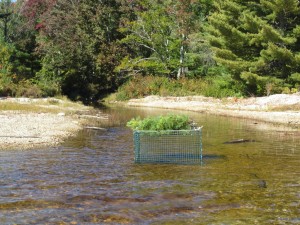 This served as a recovery room for the recuperating lake trout.[/caption]
[caption id="attachment_1111" align="aligncenter" width="225"]
This served as a recovery room for the recuperating lake trout.[/caption]
[caption id="attachment_1111" align="aligncenter" width="225"]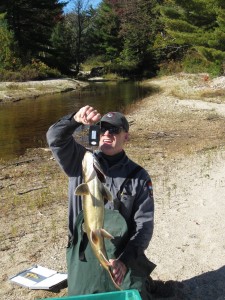 Some of the lake trout were in excess of ten pounds.[/caption]
Some of the lake trout were in excess of ten pounds.[/caption]
 Lake trout, some in excess of ten pounds, were implanted with radio telemetry tags in order to track their movements.[/caption]
Modern technology benefits anglers and biologists alike. Tiny radio transmitters, surgically implanted into lake trout, are giving fishery scientists a glimpse into a togue’s travels.
“We want to know where the fish spawn so we can get a representative sample of the spawning population,” says IFW regional fisheries biologist Greg Burr.
Getting that representative sample of togue allows biologists to give the lake trout population a periodic “check-up” to make sure that the fishery is healthy and meeting Department goals for anglers.
Timing and location are the key to gathering the fish. Togue spawn at specific locations and in a narrow window of time. “Your net placement and timing have to be precise or you will miss the fish,” Burr said.
[caption id="attachment_1110" align="alignleft" width="436"]
Lake trout, some in excess of ten pounds, were implanted with radio telemetry tags in order to track their movements.[/caption]
Modern technology benefits anglers and biologists alike. Tiny radio transmitters, surgically implanted into lake trout, are giving fishery scientists a glimpse into a togue’s travels.
“We want to know where the fish spawn so we can get a representative sample of the spawning population,” says IFW regional fisheries biologist Greg Burr.
Getting that representative sample of togue allows biologists to give the lake trout population a periodic “check-up” to make sure that the fishery is healthy and meeting Department goals for anglers.
Timing and location are the key to gathering the fish. Togue spawn at specific locations and in a narrow window of time. “Your net placement and timing have to be precise or you will miss the fish,” Burr said.
[caption id="attachment_1110" align="alignleft" width="436"] A biologist inserts a radio tag into a lake trout. An incisiion is made into the abdomen, the tag inserted and then the fish is stitched up. Clear plastic tubing delivers anesthetized water to the fish's gills, providing oxygen and keeping the fish still during the two to five minute procedure.[/caption]
Last year at Tunk Lake, biologists waited to sample togue until the water temperature got down to 50°F and were a little late and missed the spawn.
While biologists may be able to narrow down suspected spawning sites, there are no guarantees, so this year on Tunk Lake Burr and Biologist Joe Overlock captured lake trout early so they could follow their movements electronically.
Back in September they set out to catch and radio tag 10 mature lake trout in order to find out where they spawn. Using a finer mesh net than they normally would, they set the nets down deep on two separate nights in order to catch the fish they needed.
[caption id="attachment_1112" align="alignright" width="358"]
A biologist inserts a radio tag into a lake trout. An incisiion is made into the abdomen, the tag inserted and then the fish is stitched up. Clear plastic tubing delivers anesthetized water to the fish's gills, providing oxygen and keeping the fish still during the two to five minute procedure.[/caption]
Last year at Tunk Lake, biologists waited to sample togue until the water temperature got down to 50°F and were a little late and missed the spawn.
While biologists may be able to narrow down suspected spawning sites, there are no guarantees, so this year on Tunk Lake Burr and Biologist Joe Overlock captured lake trout early so they could follow their movements electronically.
Back in September they set out to catch and radio tag 10 mature lake trout in order to find out where they spawn. Using a finer mesh net than they normally would, they set the nets down deep on two separate nights in order to catch the fish they needed.
[caption id="attachment_1112" align="alignright" width="358"] This lake trout is stitched up after the tag was inserted.[/caption]
The togue they captured were alive and well because they got tangled in the nets only by their teeth. If the togue was over 19”, it was anesthetized, a radio transmitter was implanted surgically, then it was released. All others were released alive immediately.
Once the togue were released, biologists then began to follow their movements. This year using the telemetry research they found that the fish spawned when water temperatures were between 52 and 57 degrees.
“We began tracking the fish at night starting on October 8th. Tunk is two thousand acres with a lot of very deep water and a maximum depth of 222 feet. Sometimes the fish were in such deep water that you just couldn’t find them, and then you would locate them in shallower water the next night you were tracking. Many of fish traveled great distances all over the lake before settling in on the spawning shoal,” said Burr.
Over the course of the fall, Burr and crew made eight night tracking trips to Tunk, and after following the togue, were able to pinpoint the spawning grounds.
“Basically we found two shoals. One was not a surprise, but we didn’t know about the other. Both were about 3-6 feet deep,” said Burr.
[caption id="attachment_1113" align="alignleft" width="354"]
This lake trout is stitched up after the tag was inserted.[/caption]
The togue they captured were alive and well because they got tangled in the nets only by their teeth. If the togue was over 19”, it was anesthetized, a radio transmitter was implanted surgically, then it was released. All others were released alive immediately.
Once the togue were released, biologists then began to follow their movements. This year using the telemetry research they found that the fish spawned when water temperatures were between 52 and 57 degrees.
“We began tracking the fish at night starting on October 8th. Tunk is two thousand acres with a lot of very deep water and a maximum depth of 222 feet. Sometimes the fish were in such deep water that you just couldn’t find them, and then you would locate them in shallower water the next night you were tracking. Many of fish traveled great distances all over the lake before settling in on the spawning shoal,” said Burr.
Over the course of the fall, Burr and crew made eight night tracking trips to Tunk, and after following the togue, were able to pinpoint the spawning grounds.
“Basically we found two shoals. One was not a surprise, but we didn’t know about the other. Both were about 3-6 feet deep,” said Burr.
[caption id="attachment_1113" align="alignleft" width="354"] This antenna and receiver allows biologists to track the fish. Each fish has a distinct frequency.[/caption]
By tracking the fish, biologists can pinpoint where they congregate to spawn, allowing them to revisit the spawning shoal and attain a sample. They do this using a trap-net, which allows them to live capture a representative component of the population; weigh and measure them; and assess the health of the fishery.
That is important since the togue at Tunk are all wild from a population that was started in the 1930s. Currently the department no longer needs to stock togue as they reproduce naturally. However monitoring the population is essential so that their numbers do not become either over abundant or decline and upset the goals for the fishery. Since the department cannot adjust stocking numbers, tweaking the fishing regulations and sampling the population often are keys to keeping a topnotch fishery.
[caption id="attachment_1114" align="alignright" width="436"]
This antenna and receiver allows biologists to track the fish. Each fish has a distinct frequency.[/caption]
By tracking the fish, biologists can pinpoint where they congregate to spawn, allowing them to revisit the spawning shoal and attain a sample. They do this using a trap-net, which allows them to live capture a representative component of the population; weigh and measure them; and assess the health of the fishery.
That is important since the togue at Tunk are all wild from a population that was started in the 1930s. Currently the department no longer needs to stock togue as they reproduce naturally. However monitoring the population is essential so that their numbers do not become either over abundant or decline and upset the goals for the fishery. Since the department cannot adjust stocking numbers, tweaking the fishing regulations and sampling the population often are keys to keeping a topnotch fishery.
[caption id="attachment_1114" align="alignright" width="436"] All location data is recorded and analyzed.[/caption]
“Our goals at Tunk are to increase the number of larger fish available to anglers. That is why we implemented the no-kill slot limit. Knowing where these fish spawn will allow us to follow the trend of larger spawning fish and show us if we are reaching our size goals. We want to provide the best fishery possible for those who decide to fish Tunk,” said Burr.
Currently, things are going well at Tunk. The length-to-weight ratios for togue and salmon are excellent, which is good news for fisherman looking to catch big fat fish.
“We are extremely pleased on how these fisheries are coming along at Tunk. Four of the ten togue tagged were over 10 pounds and we feel there many more like these or even larger out there. Anglers should be excited for the future,” said Burr.
[caption id="attachment_1116" align="alignleft" width="300"]
All location data is recorded and analyzed.[/caption]
“Our goals at Tunk are to increase the number of larger fish available to anglers. That is why we implemented the no-kill slot limit. Knowing where these fish spawn will allow us to follow the trend of larger spawning fish and show us if we are reaching our size goals. We want to provide the best fishery possible for those who decide to fish Tunk,” said Burr.
Currently, things are going well at Tunk. The length-to-weight ratios for togue and salmon are excellent, which is good news for fisherman looking to catch big fat fish.
“We are extremely pleased on how these fisheries are coming along at Tunk. Four of the ten togue tagged were over 10 pounds and we feel there many more like these or even larger out there. Anglers should be excited for the future,” said Burr.
[caption id="attachment_1116" align="alignleft" width="300"] This served as a recovery room for the recuperating lake trout.[/caption]
[caption id="attachment_1111" align="aligncenter" width="225"]
This served as a recovery room for the recuperating lake trout.[/caption]
[caption id="attachment_1111" align="aligncenter" width="225"] Some of the lake trout were in excess of ten pounds.[/caption]
Some of the lake trout were in excess of ten pounds.[/caption]Categories